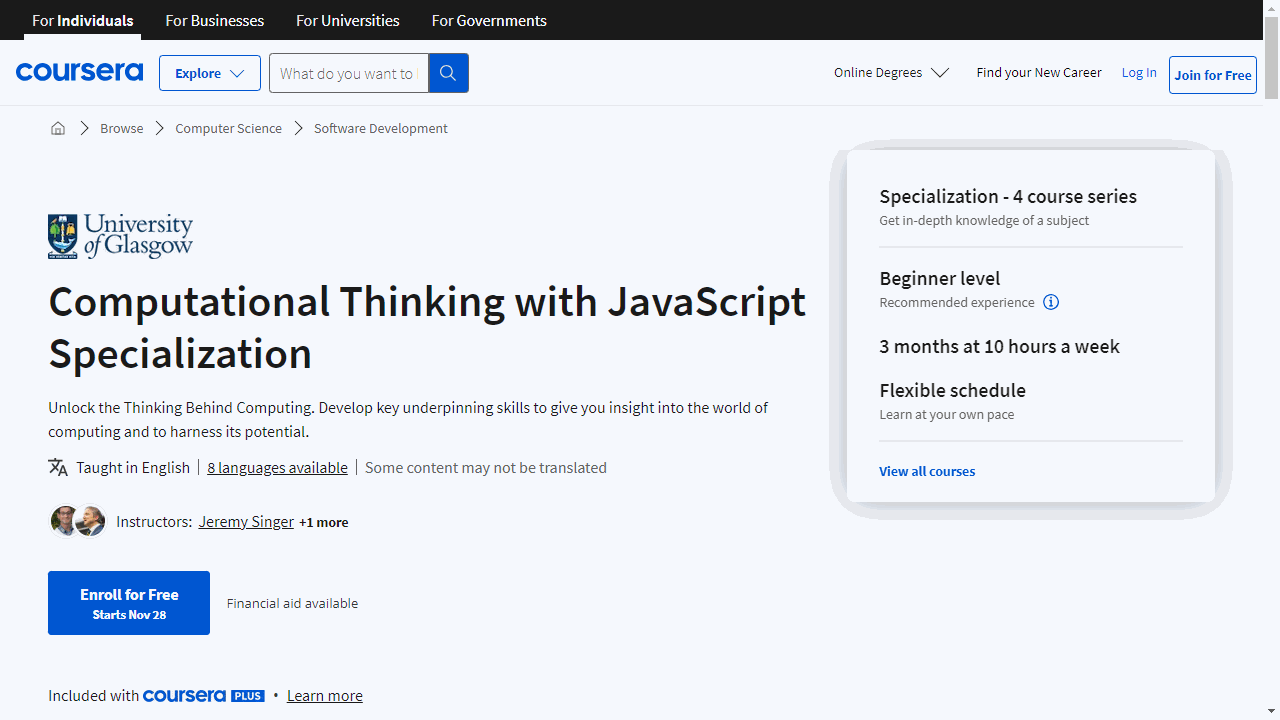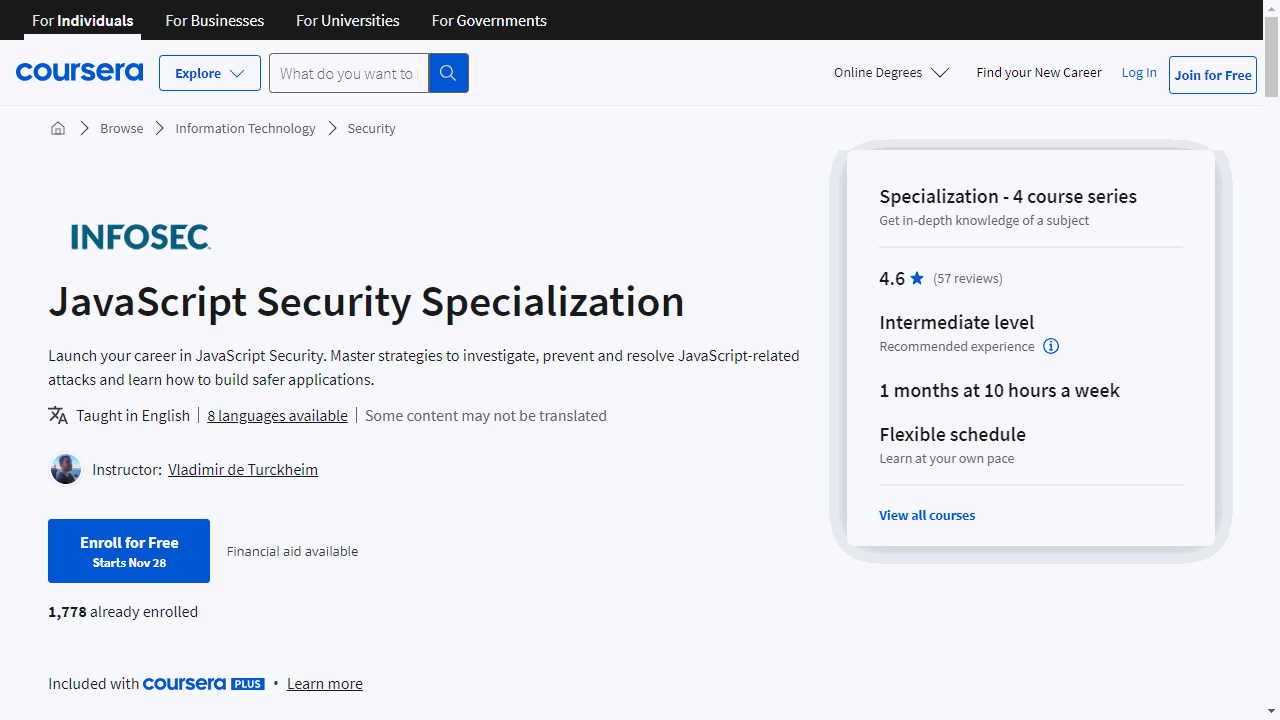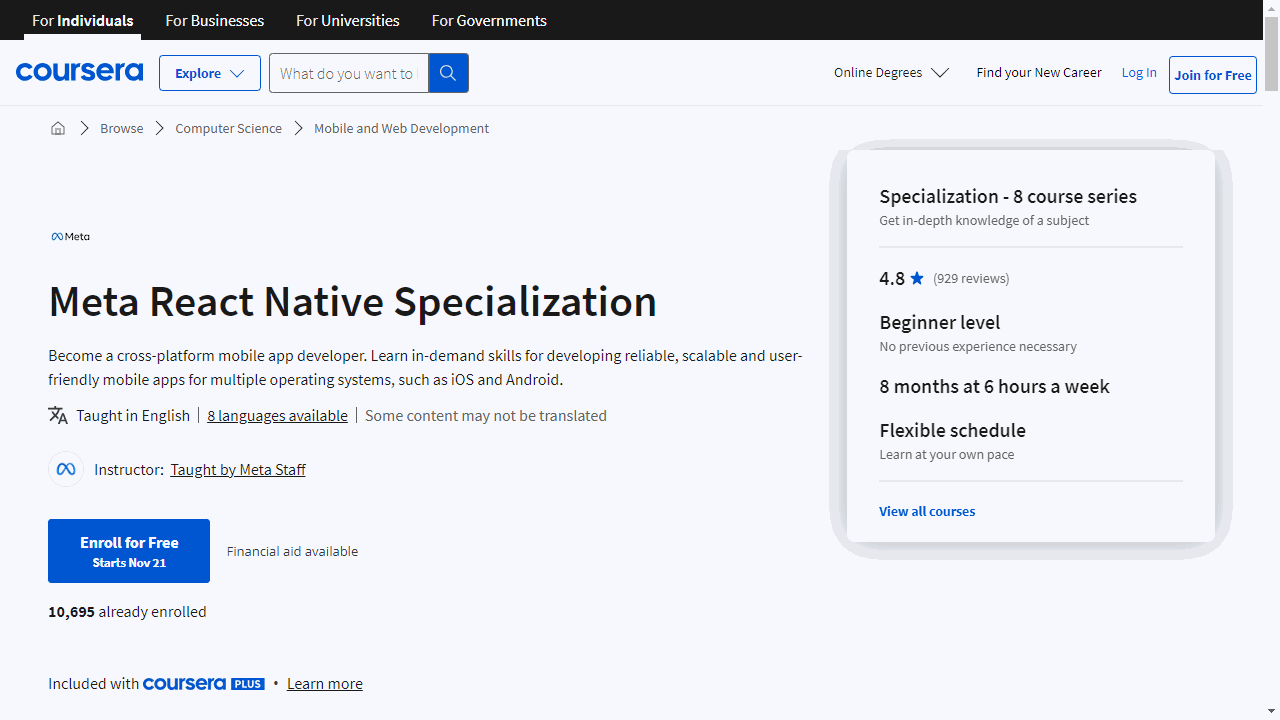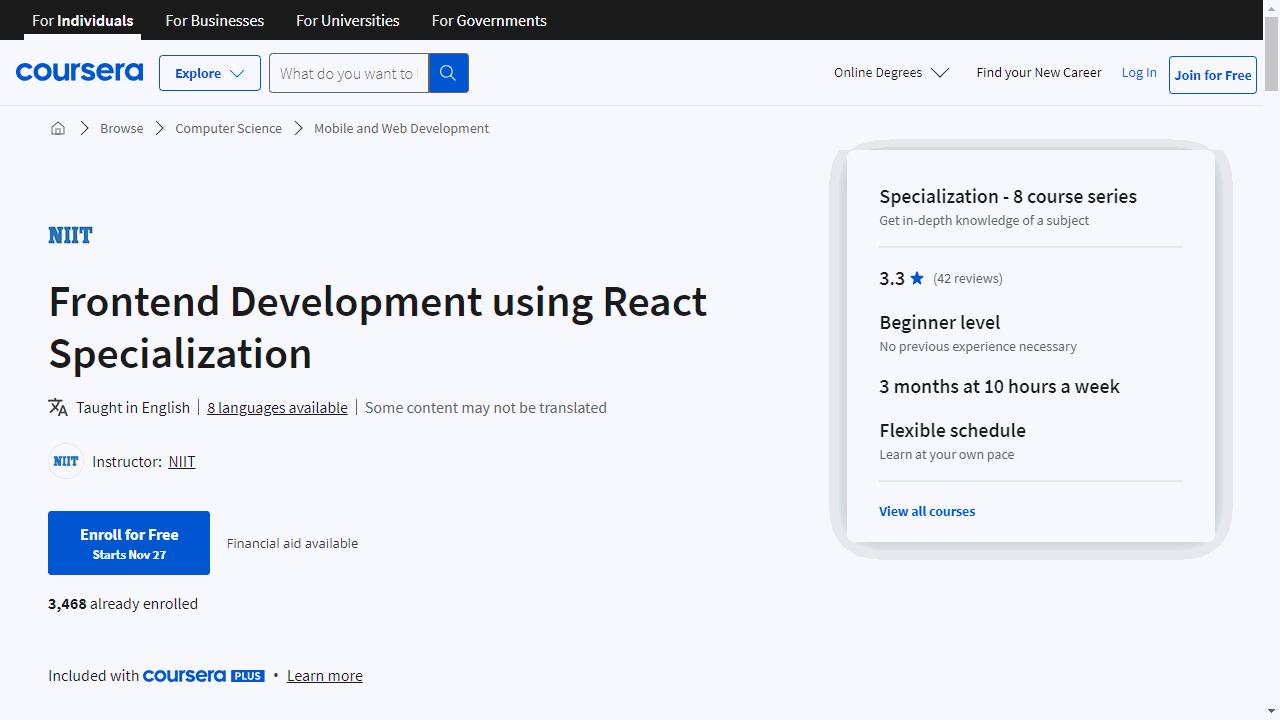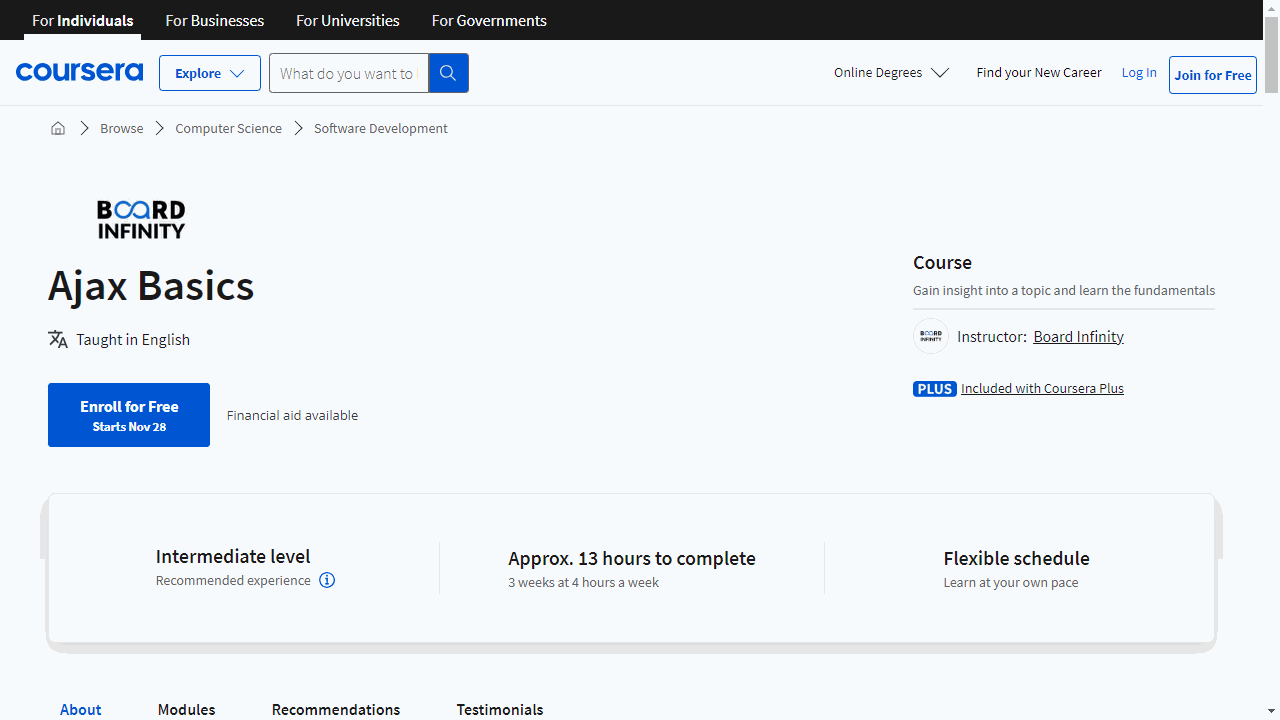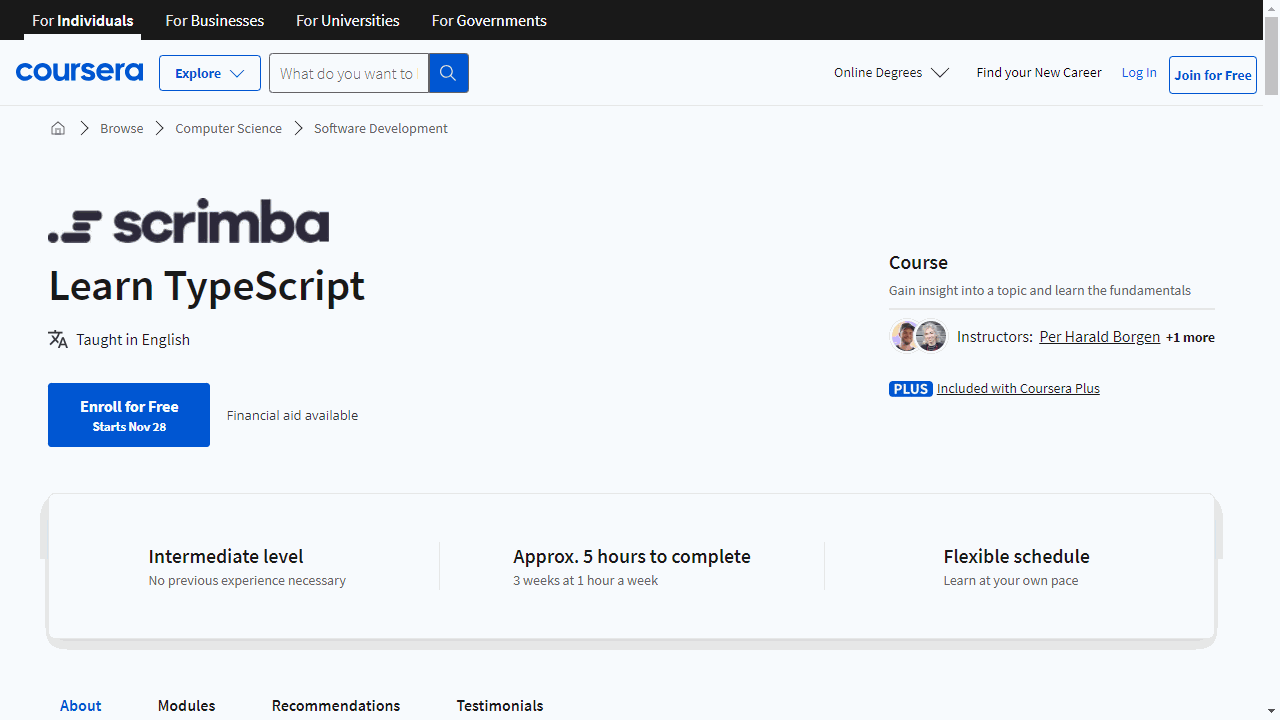JavaScript is a powerful and versatile programming language that forms the backbone of modern web development.
It allows you to create interactive and dynamic web pages, making websites more engaging and responsive for users.
Learning JavaScript opens doors to a wide range of career opportunities in web development, from front-end to back-end development and beyond.
Finding the right JavaScript course on Coursera can be a challenge, especially if you’re just starting out.
You want a program that’s comprehensive, engaging, and taught by experts, but also fits your learning style and goals.
We’ve reviewed countless courses and determined that the Computational Thinking with JavaScript Specialization is the best course overall.
This four-course program from the University of Glasgow stands out for its engaging approach and focus on practical application.
You’ll learn JavaScript fundamentals through interactive projects like drawing and animation, then delve into data handling and analytics, before finally creating your own interactive web pages.
This specialization is perfect for beginners who want to learn JavaScript and computational thinking from the ground up.
Of course, there are many other great JavaScript courses on Coursera, and we’ve compiled a list of our favorites for different learning levels and interests.
So keep reading to find the perfect JavaScript course for you!
Computational Thinking with JavaScript Specialization
This specialization is ideal for beginners and those looking to deepen their understanding of JavaScript and computational thinking.
The journey begins with “Computational Thinking with JavaScript 1: Draw & Animate,” where you’ll grasp the fundamentals of JavaScript through engaging projects like drawing and animation.
This course lays a foundation in computational thinking and programming principles, essential for any tech enthusiast.
As you progress to “Computational Thinking with JavaScript 2: Model & Analyse,” you’ll delve into data handling and analytics.
Here, you’ll learn to manipulate and visualize data, a skill set in high demand across industries.
The course emphasizes practical JavaScript applications, ensuring you can apply what you learn to real-world scenarios.
In “Computational Thinking with JavaScript 3: Organise & Interact,” the focus shifts to web development.
You’ll explore the synergy between HTML and JavaScript, creating interactive web pages.
This course introduces you to new libraries and tools, expanding your coding repertoire.
The capstone, “Computational Thinking with JavaScript 4: Create & Deploy,” synthesizes your learning.
You’ll undertake a project from conception to deployment, navigating the software development process with guidance.
This hands-on experience is invaluable, cementing your understanding and preparing you for real-world challenges.
Each course is rich with practical skills, from programming principles to software development techniques.
JavaScript for Beginners Specialization
If you are looking for a career in web development, JavaScript is a must-know language.
This set of four courses provides a thorough introduction to JavaScript, the most popular programming language for creating interactive websites.
In the first course, JavaScript Basics, you’ll gain foundational knowledge of how JavaScript works and how to write basic scripts. Guidance is provided if you need to brush up on HTML and CSS skills.
By the end, you’ll be able to work with variables, arrays, loops, and control structures - core programming concepts you’ll build on later.
The next course focuses on animations using the jQuery library.
You’ll learn how jQuery makes it easier to manipulate HTML and CSS for sleek, responsive effects on your site. Coding animations from scratch can be complex, but jQuery simplifies it.
By the end, you’ll have built an entire landing page animated with jQuery!
Interactivity with JavaScript and jQuery takes it further by introducing more advanced jQuery plugins and techniques.
You’ll make your pages even more dynamic by modifying objects and the DOM in response to user input. It’s all about making websites feel alive.
Finally, Data Manipulation in JavaScript teaches you how to work with external data sources.
You’ll learn practical skills like input validation and displaying data on the page. The course includes projects to put your new skills to the test.
With its hands-on focus, expert instructors, and real-world applications, this Coursera Specialization gives beginners like you a rock-solid foundation in JavaScript.
The skills you gain will enable you to make your websites more responsive, interactive, and data-driven. If you want to learn web development the right way, this is the perfect place to start.
JavaScript Security Specialization
If you’re searching for a comprehensive JavaScript course with a focus on security, this is the one.
This series of courses is designed to equip you with the skills to write secure JavaScript code, an essential asset in today’s digital landscape.
Start with the “JavaScript Security Refreshers” course, where you’ll get a thorough overview of secure JavaScript programming.
It’s an essential primer on authentication best practices and a refresher on the core elements of JavaScript, web browsers, and Node.js.
Move on to “JavaScript Security Part 1,” where you’ll delve into critical security threats such as Cross-Site Scripting (XSS) and JavaScript Remote Code Execution.
You’ll also learn about Cross-Site Request Forgery (CSRF) and the intricacies of browser security, arming you with the knowledge to protect web applications against common attacks.
In “JavaScript Security Part 2,” the focus shifts to advanced topics like Expressions and Prototype Pollution, as well as navigating the npm ecosystem and understanding the supply chain’s role in security.
These concepts are key to maintaining the integrity of your code in a complex development environment.
Finally, “JavaScript Security Part 3” rounds out the specialization with insights into Serverless JavaScript and securing your development setup with Web Developer Desktop Security.
This course ensures you’re prepared to work with the latest serverless architectures while keeping your local environment protected.
Each course is rich with practical skills, from Node.js to JavaScript, and is taught by industry experts.
Build Website with HTML, JavaScript, AngularJS, and React Specialization
Starting with “Build a Webpage with HTML and CSS,” you’ll grasp the essentials of web structure using HTML and enhance visual appeal with CSS.
The course simplifies complex concepts, ensuring you understand how to structure content and style web pages effectively.
Bootstrap training is included, equipping you with the skills to create responsive designs that adapt to different devices.
Moving on to “JavaScript for Web Development,” you’ll delve into the language that adds interactivity to websites.
The course covers everything from JavaScript basics to the Document Object Model (DOM), enabling you to manipulate web pages in real-time.
You’ll also learn jQuery, which simplifies code and accelerates development, allowing you to implement dynamic features with ease.
The final course, “Libraries and Frameworks for Frontend Development,” introduces you to the powerhouses of modern web development: React and Angular.
You’ll explore React’s efficient UI design and Angular’s scalable application structure.
The course culminates in a project that combines these technologies, showcasing how they can work together to create sophisticated web applications.
By the end of the specialization, you’ll have a solid foundation in web development, equipped with the skills to build responsive, interactive websites.
Meta React Native Specialization
This specialization is designed to equip you with the skills needed to thrive in the mobile app development space.
The journey begins with “Introduction to Mobile Development,” where you’ll get a clear picture of a mobile developer’s role.
You’ll start with the essentials, HTML and CSS, and quickly move on to the exciting realm of cross-platform apps with React Native.
This course sets a strong foundation, essential for what’s to come.
As you progress to “Programming with JavaScript,” you’ll delve deeper into the language that’s essential for web and mobile app interactivity.
You’ll tackle practical exercises that will solidify your understanding of JavaScript fundamentals, and you’ll learn how to test your code effectively using Jest, ensuring your applications run smoothly.
In “Version Control,” collaboration becomes the focus.
You’ll learn how to use Git and GitHub, tools that are indispensable for working in teams and managing code changes.
This course is crucial for understanding the workflows that keep large-scale projects organized and running efficiently.
“React Basics” is where you start building.
You’ll explore React’s component-based architecture, learning to create interfaces that update dynamically and respond to user input.
This course is about making your apps intuitive and engaging, a skill that’s highly valued in the industry.
With “React Native,” you’ll apply your React knowledge to mobile app development.
You’ll practice building components, managing state, and navigating between screens.
This course is key to understanding how to leverage React’s capabilities to create apps that feel native to both Android and iOS platforms.
“Working with Data” shifts your focus to the backend, teaching you how to handle data within your React Native applications.
You’ll learn about REST APIs, SQL, and data storage solutions like AsyncStorage and SQLite.
This course ensures your apps are not just visually appealing but also robust and data-driven.
The “Principles of UX/UI Design” course is where design meets function.
You’ll learn to create user-centric designs, understanding the importance of empathy in UX research and the practicalities of UI design with tools like Figma.
This course is about ensuring your apps are not only functional but also enjoyable to use.
Finally, the “Capstone (React App)” is where everything you’ve learned comes together.
You’ll take on a real-world project, applying your skills to build an app from the ground up.
This is your opportunity to create a portfolio piece that demonstrates your comprehensive understanding of mobile app development.
If you’re serious about becoming a mobile developer, this specialization is a great place to start.
Frontend Development using React Specialization
This specialization is a comprehensive path to becoming proficient in React JS, offering a blend of foundational knowledge and advanced techniques.
The journey begins with “Introduction to building Web Pages using HTML5 and CSS3,” where you’ll grasp the fundamentals of structuring and styling web pages.
It’s the foundation you need to create content that’s both visually appealing and accessible.
As mobile browsing dominates, “Developing Responsive Web Pages Using HTML5 and CSS3” ensures your designs look great on any device.
You’ll learn to use modern CSS and Bootstrap to craft responsive layouts that adapt seamlessly to different screens.
Interactive elements are crucial for user engagement, and “Building Interactive Web Pages Using Modern JavaScript” equips you with JavaScript skills to animate and enliven your web pages.
This course is your stepping stone to creating dynamic content that captivates users.
React’s power comes to the forefront in “Building Interactive User Interfaces Using React Library.”
Here, you’ll delve into Single Page Applications (SPAs) and React Class components, learning to build fast, responsive, and navigable user interfaces.
“Building User Interfaces Using Functional React Components” introduces a modern approach with functional components and React Hooks.
This course focuses on enhancing code readability and reusability, ensuring your applications are efficient and maintainable.
In “Building High Quality User Experience Using Material UI,” you’ll discover how to leverage Material UI and CSS-in-JS to design visually stunning and user-friendly interfaces.
This course is all about elevating the aesthetic and functional quality of your applications.
“Building Navigational Workflows Using React” tackles the intricacies of form creation and navigation within your applications.
You’ll get hands-on with React forms, Formik, and React Router, learning to build intuitive and complex workflows.
The “Capstone Project” is where you apply your newfound knowledge to a practical challenge, synthesizing the skills you’ve developed to produce a project that adheres to professional standards.
Ajax Basics
This course offers a comprehensive understanding of AJAX, the technology that enables web pages to update seamlessly, akin to texting without refreshing your messages.
Starting with the basics, you’ll learn about the XMLHttpRequest object, the core of AJAX that facilitates communication between web pages and servers.
You’ll also gain insight into the mechanics of HTTP – the protocol that powers internet conversations through messages, requests, and responses.
The course then guides you through JavaScript and jQuery essentials.
You’ll discover how to incorporate jQuery into your web pages and harness selectors and event handlers to create interactive elements.
This is where your web pages start to respond and engage with users in real time.
You’ll also become adept at using jQuery methods like Load, Get, and Post to fetch data, similar to placing an online order.
This is crucial for creating dynamic content that doesn’t require page reloads.
As you progress, the course delves deeper into AJAX with JavaScript and jQuery.
You’ll explore asynchronous programming, the Fetch API, and how to manipulate the DOM.
The course also covers creating visual effects and animations to enhance user experience.
Building AJAX-powered web applications is a key component of the curriculum, along with debugging and troubleshooting techniques to ensure your code is robust and reliable.
Data handling is also a major focus, with lessons on JSON, the preferred format for web data exchange.
You’ll learn to display, construct, and parse JSON, as well as XML data, ensuring you can handle various data types effectively.
To round out your learning experience, the course introduces advanced error-handling techniques and performance optimization best practices.
Real-world AJAX applications are examined to provide context and demonstrate practical usage.
Learn TypeScript
TypeScript enhances JavaScript by introducing types, which act as a safeguard against errors, making your code more robust and maintainable.
Starting with the essentials, the course demystifies TypeScript, setting a strong foundation by explaining its relationship with JavaScript.
You’ll quickly move on to hands-on challenges that solidify your understanding of TypeScript’s basic building blocks: number, string, and boolean types.
As you progress, you’ll apply your knowledge to real-world tasks, such as debugging a website, showcasing TypeScript’s ability to preempt common coding issues.
The curriculum delves into more complex types like objects, arrays, tuples, enums, and unions, each accompanied by mini-challenges that reinforce your learning through practice.
The course also covers function types and void types, ensuring your functions behave as intended.
You’ll learn to organize your code effectively using interfaces, modules, and classes, skills that are crucial for managing larger projects.
Beyond types, the syllabus includes a segment on styling, teaching you to enhance user interfaces with hover effects and consistent color schemes.
This holistic approach ensures you not only write better code but also create visually appealing web components.
You’ll have a comprehensive understanding of TypeScript, evidenced by a fully functional, stylish website.
This course not only prepares you to write cleaner code but also sets a clear path for continued learning in web development.
